
MALE PUBERTY, HEROIC FANTASY and ROCK MUSIC
When I was seventeen, I won a prize at the Tupelo Fair and Dairy Show for shooting water into a clowns mouth: a framed orange and creme, disco decco, rock & roll art piece, suitable for framing on a teenage bedroom wall.
The rock stars depicted were local boy ELVIS PRESLEY, JOHN LENNON (two months from being killed), and Mick Jagger, whose LET IT BLEED vinyl and GET YER YA-YA'S OUT cassette would fall into my hands the following year. My junior term paper was to be on the Beatles and my senior paper would be on the Stones.
But who was the blonde fellow in the lower right corner of the rock & roll prize? At the time, I had no idea. And in retrospect, why is Bowie not pictured as Ziggy? Though if one traces across the chronology on the picture, the finger must “zig”.
I find it more amazing that Bowie is even included at all. Why not Hendrix or Morrison?
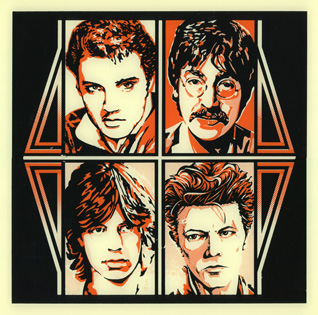
Freddie Mercury, my true idol in 1980, was not pictured on the rock & roll prize at all. I'm sure I was upset. I loved Queen.
They were the most exotic band that I could get my hands on, in my loin-cloth wearing, high-school mustache, Wal-Mart existence, living in the middle of nowhere, as I did - in Jericho, Mississippi.
Everyone hated Queen, so they weren't on any American TV shows. The release of "The Game" in 1980 didn't change that. In retrospect, Crazy Little Thing Called Love" should have been recorded in Memphis.
Bowie would eventually collaborate with everyone on that orange picture (except Elvis, but, both Bowie and Elvis shared a birthday). By the next year, Mercury would collaborate with the man who left Mars behind some 9 years before. My first exposure to Bowie was through Queen with "Under Pressure".
1981 would close the teenage window of Queen fanaticism for me. That year, at the Tupelo Fair & Dairy Show, I would win a framed Queen mirror. But it shattered sometime later, like the back cover of SHEER HEART ATTACK, and eventually, like my boyhood interest in Queen.

UNDER PEER-PRESSURE
My summer project in 1980 had been to airbrush Larry Lineberry's black van with Meatloaf's "Bat out of Hell" album cover (Richard Corben's painting of a motorcycle screaming out of an open grave). On the other side, I had done my teen-age best to massacre Frank Frazetta's "Viking in the Pass". This painting had been used on Molly Hatchet's "Flirting with Disaster". To finish it off, I had stenciled my name and phone number on the wheel cover: VAN ART: Mike McCarthy 662-365-5833.
No one called.
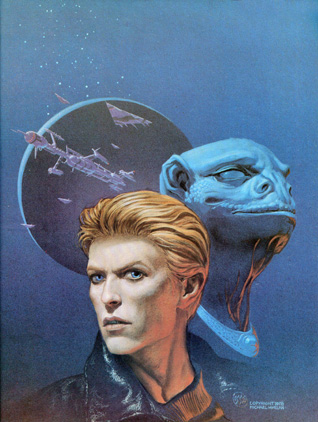
Larry Lineberry would haul us drunk redneck teenagers up to Memphis to the Mid-South Coliseum to see Ted Nugent's "Intensities" tour, Blackfoot, 38 Special, Van Halen "Fair Warning", and Iron Maiden. Is it possible to hold onto to these juvenile memories like a badge of honor? YES. I was not killed on HIghway 78 and I still passed my senior year, long hair and all.
Somehow, through all of this, I missed my chance to see Queen perform "The Game" at the Mid-South Coliseum in 1980. It would be the last time they would ever come to Memphis. Perhaps my southern-rock brethren thought Freddie was too gay to bother with.
But wasn't Jagger gay as well? That's all I heard from my junior high friends every time I played "Let It Bleed". Somehow, it was reassuring to hear Keith sing. But, I was consoled. If Mick was demonic in a blues way, then Freddie was daemonic in a “Faerie Queen” kind of way.
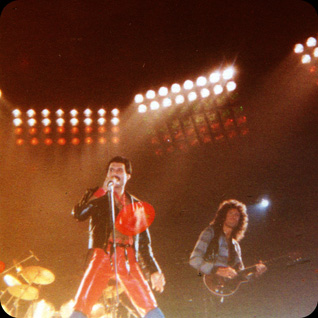
QUEEN, 1980; Mid-South Coliseum, Memphis, Tenn.
I heard "Diamond Dogs" for the first time at Mike Curtis's gravel road comic book store (dubbed “Crystal City”), but I didn't connect the sound (or cover art) with what few painterly images of Bowie I possessed. Though Guy Peellaert's painting of Bowie as half-man, half dog is the ultimate in visual rock art bravado.
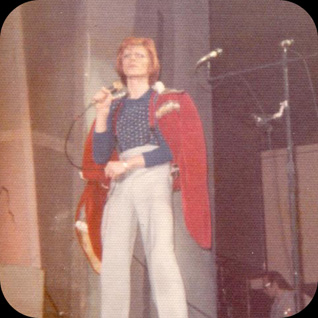
Bowie Diamond Dogs Tour, 1974;
Mid-South Coliseum, Memphis, Tenn.
I had seen Bowie's image only once before, illustrated in a sci-fi fantasy art book called “Wonderworks” by British illustrator Michael Whelan. I had bought the book to peruse the collection of Elric of Melnibone book covers Whelan had illustrated in the late seventies.
I had read all six books of Michael Moorcock's “ELRIC OF MELNIBONE”. Elric was an albino prince who killed his enemies with a six foot long sword called Stormbringer that drank the souls of it's victims. I had visualized Freddie Mercury as ELRIC'S evil cousin "Yyrcoon" and made this point (to no end) in the letter columns of the Comic Buyers Guide and EPIC Magazine.

Elric by Mike McCarthy circa 1980
In the book “Wonderworks”, Michael Whelan paints Bowie in an whacked out Sci-Fi world but neglects to differentiate his eye color. It's an interesting interpretation but lacks the dystopia one finds in Bowie's work. There is no Anthony Burgess effect, no William Burroughs decay.
An ELRIC movie has never materialized, though now it is very plain to see (from the heavy metal 80's look of LABYRINTH down to the few pages in the Whelan art book that separate Albino Elric from the Thin White Duke) that David Bowie could have played “ELRIC OF MELNIBONE”.
CBG Fan writer Terry Beatty would take my enthusiastic ideas to task, raking my (poor) writing skills over the coals on two published occasions.
You see, Terry was into New Wave.
Bowie Painting by Michael Whelan from WONDERWORKS, 1979

1974: QUEEN 2 and SHEER HEART ATTACK
On my very first trip to Memphis Comics and Records in 1980, I discovered QUEEN 2 in the used record bin. I had no idea the record existed at all. It was released in 1974, the same year as my favorite Queen record SHEER HEART ATTACK. How could this be? Two Queen records in one year?
QUEEN 2 would become my new fave.
The record has a black side and a white side and spoke to a time of ogres and faeries - perfect timing for my interest in Tolkien, Burroughs, and Howard. Freddie's lush phrasing is other-wordly, somewhat shocking, and even politically incorrect (though not mean-spirited) when he asks for “a little nigger sugar” in “March of the Black Queen”.
Mick Rock, "Bowie's photographer", takes the macabre photo that graces the cover of QUEEN 2, the greatest visual representation that the band will ever have. Mick Rock also takes the cover photographs for SHEER HEART ATTACK (wherein Freddie's chest hair increases on the back cover.)
The smash hit “Killer Queen” (SHEER HEART ATTACK) could be Freddie's answer to “Queen Bitch”. In “Killer Queen”, Freddie finds a true voice: no longer just a man, or a daemon, but in adoration of a man who dresses like a woman. Bowie's "Queen Bitch” (and Ray Davies” Lola”) are 'first person' accounts of a transvestite who's lives a gritty street life. “Killer Queen” comes off 'third person', yet Freddie is singing about himself as a woman who dominates through decapitation and sexual tastes as much as sex itself.
“Killer Queen” oversees and controls 'her' world (much like the apolloniac harbinger who inhabits “Seven Seas of Rhye” or “March of the Black Queen” (QUEEN 2). One imagines Brian DePalma being inspired by images for his cross-dressing serial killer in “Dressed to Kill”. Killer Queen is indeed a Psycho who would never be taken alive.
Hitchcock in black leather, dog collar and chains.
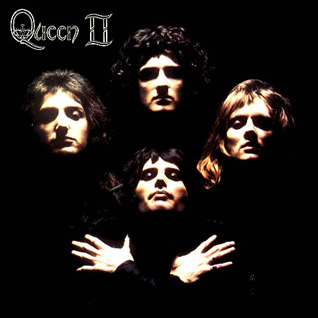
TENEMENT THEORIES
Bowie's record “Hunky Dory”, which closes with the song “Queen Bitch”, is released on December 17, 1971. Queen is formed in 1971 after bassist John Deacon officially joins the band.
How many times would Freddie hear Bowie sing "Queen Bitch" (before it's release) at underground venues about London in 1971? It is my opinion that Bowie's flirtations with 'queens' in the popular sense, in the Warhol sense, and how he appeared in public greatly influenced Freddie ((Farrokh Bulsara) Mercury to consider what to call his new band.
It is also appeals to my logic that Freddie changed his name to "Mercury" because "Mars" had already been taken by Bowie for the Spiders.
When I first heard Mick Ronson play, I thought the tone sounded very much like Brian May. I had it backwards. Brian May's unique guitar playing skill was augmented by a very English sound developed first by Producer Tony Visconti through Marc Bolan and T-Rex. That sound of syrup being poured over infinite octaves was also appropriated by Mick Ronson and the Spiders From Mars. Now the Chuck Berry riff existed quintessentially in two camps; the Exile on Main Street traditionalists … and as a distorted fever in the foppish epicene known as Glam.
HOOPLE DREAMS
The spirit of the Beatles inhabits both Brian May and David Bowie: On the first QUEEN record, May writes “Lucy was high and so was I” in “The Night Comes Down” (1973). Bowie writes in "All the Young Dudes" (1972) with “Now Lucy looks sweet cause he dresses like a queen...”.
“With “Lap of the Gods”, (SHEER HEART ATTACK), Freddie cops the melodic feel and texture of “Silly Boy Blue”, easily the best song on Bowie's eponymous LP. Even to the point of a self-conscious fade-and-return, a curious dramatic effect' used for both songs.
So it is that Bowie cancels his spot on England's “Top of the Pops” television show and Queen hastily fills in, singing "Seven Seas of Rhye" (QUEEN 2). Mott the Hoople asks Queen to open for them on their 1974 North American tour. Queen references Hoople in “Now I'm Here” from SHEER HEART ATTACK with “...down in the city just Hoople and me.”.
Repeated performances of the Bowie-penned Hoople favorite "All the Young Dudes" dwells in Freddie's competitive mind until he eventually writes the answer song: "We are the Champions" as an answer song in 1977. “We Are The Champions” is a populist mantra, and as much an 'end piece' to Glam as Bowie's elitist “Heroes” of the same year. Both songs carry the same metaphor: a plural victory over the human condition.
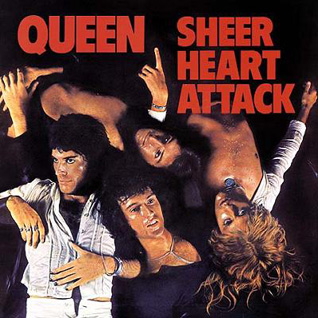

BLOOD RELATIONS
In an elegant, yet desperate, attempt to appeal to teens and sell records while still maintaining some shred of a personal, Dylanesque, message - all for the sake of theatre. This is the epitome of a post-psychedelic world - gone decadent. This is the heart and soul of Glam.
“Seven Seas of Rhye” ends QUEEN 2 with the band singing “I Do Like To Be Beside The Sea”. You can hear Freddie whistling the same tune during the beginning of SHEER HEART ATTACK, tying the two records together as a wishful double LP.
“Seven Seas of Rhye” on QUEEN 2 is poetically answered by “Lily of the Valley” on SHEER HEART ATTACK. The characters belong to a childhood fantasy created by Freddie and his sister. Other songs are inspired by “The Fairy Fellers Master-Stroke” a painting by Richard Dadd and obsession of Freddie's, which served also as another fitting metaphor for Freddie's sexuality.
When Brian May (Hepatitis-sufferer) sings to family (which is quite often), it is from a sentimental place, of a longing to be home. When Freddie Mercury (Aids-sufferer) sings to family, or, to the long time 'love of his life', Mary Austin, he appears to be asking for forgiveness.
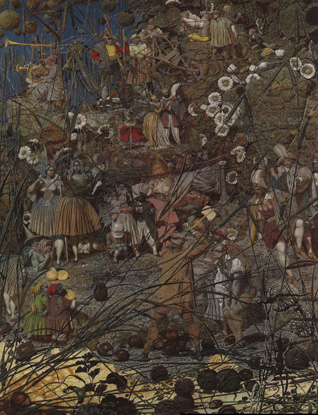
Richard Dadd's Fairy Feller's Master-Stroke 1855–64
The majority of Queen's lyrical content (as sang by Freddie) is an apology for a sexual preference that goes against social customs and the laws of Man. The next time you hear “Bohemian Rhapsody”, think about this.
DECADENT PSYCHEDELIA
Bowie's sexuality was Warhol-affected. A sexuality that was more cold, more Kubrick in scope. No one gets excited about sex with a soup can. Even Warhol's Marilyn portraits are more 'art-on' than 'hard-on.
But it was Warhol's tastes in the avante-garde sound of the Velvet Underground that counted most for Bowie's passionate reverence. Bowie, in the wake of his long dresses, told Melody Maker in January, 1972, "I'm gay and I always have been…" He was setting the stage for Ziggy.
It must have ruffled Mercury's feathers (so to speak) to have read Bowie's grandiose "coming out" statement. For it was Freddie Mercury who was truly gay. David Bowie seems to be bi-sexual, at best, having only flirted with the life-style while married to Angie.
So Bowie lied?
Not quite. As is true of all humans who don't quite feel at home on Earth, Bowie was closer to being an alien than he was to being gay. This is what Glam is all about; electric poems to the race that abandoned us here. Glam says there is no missing link, no evolution, and no creationism. Just some ape girl's skull named after..(you guessed it) “Lucy in the Sky with Diamonds”. We came here fully formed, in a mood to survive, not co-exist. We destroy Nature in the name of Progress.
We are the end all and be all.

Freddie's protruding fangs and 'Cleopatra hair-do' made him look downright evil. A pretty Sid Vicious to Bowie's carrot-shocked Johnny Rotten. Freddie did look like an Elric villain, or Philippe Caubère's as "Moliere" on PBS, or a dungeon master called to use his voice as a weapon in the middle of a Mississippi role playing game. There was no time to ever think that he might be gay.
On the other hand, how could a mere heterosexual ever write "Seven Seas of Rhye"?"
This is not the benevolent face of glam epitomized by Ziggy Stardust from one year earlier where he sings 'Starman' (a melody copped from 'Somewhere over the Rainbow'). This is ROCK MUSIC. And if Bowie comes off like Dorothy, then Freddie is the Wicked Witch.
'Seven Seas of Rhye” promises escape to a new world of sexual chaos and wild abandon in the form of an angry love letter; the promise of Ziggy Stardust gone horribly awry; where Mercury is a super-powered homosexual vampire hellbent on the annihilation of not just Man's law, but Nature itself.
'Seven Seas of Rhye' is Freddie Mercury's 'coming out' statement.
“Seven Seas of Rhye”
fear me you lords and lady preachers
i descend upon your earth from the skies
i command your very souls you unbelievers
bring before me what is mine
the seven seas of rhye
can you hear me you peers and privvy counselors
i stand before you naked to the eyes
i will destroy any man who dares abuse my trust
i swear that you'll be mine
the seven seas of rhye
sister - i live and lie for you
mister - do and i'll die
you are mine i possess you
i belong to you forever
storm the master-marathon i'll fly through
by flash and thunder-fire i'll survive
then i'll defy the laws of nature and come out alive
then i'll get you
be gone with you - you shod and shady senators
give out the good, leave out the bad evil cries
i challenge the mighty titan and his troubadours
and with a smile
i'll take you to the seven seas of rhye

1973
'ROCK & ROLL' DIES, between the post-glam world of July 3, 1973 - which is the final performance of 'Ziggy Stardust and the Spiders From Mars', and the October Divorce of Elvis and Priscilla Presley.
At this point in Elvis's life, he does not need to release relevant music anymore. It is his very lifeline which is now (and has always been) a metaphoric guideline for everything that happens within Pop Culture). The Golden Age of American Pop Culture has four years left of dying.
By November, 1973, “Rock & Roll” becomes ROCK. The primal beat gives way to the descending drum roll.
Therefore, it can be said that Led Zeppelin's pre-'73 records are Rock & Roll, and it's post-73 records are “ROCK”. Let us not forget KISS, the epitome of ROCK, who are formed in this very premeditated way in the fall of 1973.
The last rock and roll album from the glam era is Iggy Pop and the Stooges "Raw Power" (1973). Bowie treated it like a stepchild when he mixed it, and was not speaking to Iggy when it was released. This record lays the seeds for Punk, and for the term 'rock and roll' to grow within the Punk idiom and be used again through 1977 when Punk finally hits the charts (and Elvis dies).
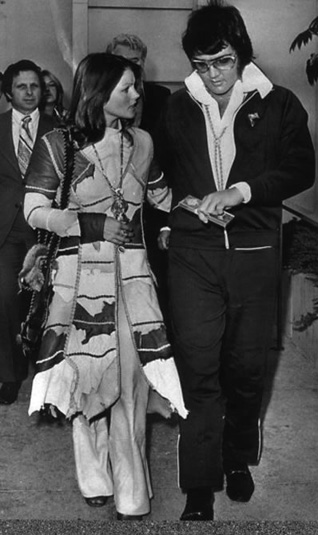
You could say that Rock & Roll survives the Disco era by dividing into the twin dynamos of Glam and Punk.
Queen, in effect, try hard to be a rock and roll band, but they can't. That was Mott the Hoople's job. Their rock-out of “Little Queenie” at the end of “Now I'm Here” is more for nostalgia than anything else. Bowie escapes the problem of ROCK all together by becoming a keyboardist, hiding in Iggy's band during the STATION TO STATION tour.
Three of the most indelible images in music from 1977 are the Kelly Freas fantasy re-painting for Queen's "News of the World" cover, Jamie Reid's "God Save the Queen" record cover for the Sex Pistols, and the photograph of Elvis Presley (the king) laying at peace in his coffin on the cover of the National Enquirer.
The National Enquirer and News of the World were both tabloids who would later report the death of Freddie Mercury, perhaps the most hedonistic rock star of all time. He does not die from prescription, nor assassination, nor overdose, or rock and roll suicide. He dies from pleasure. Freddie lived the lyric of 'Seven Seas of Rhye' and 'Killer Queen'.
Freddie's only fault, in my book, is that he veered too far from the epicene, and in doing so, too far from rock and roll, which is the main fault of ROCK music at all.

WE ARE THE SORE LOSERS
At 13, I bought the single “We are the Champions/We Will Rock You”. I remember standing in line at Woolco Department Store in 1977 watching some cool kid buy the News of the World LP. Too intimidating for me, I guess. Queen was my foray into ROCK, but I was taking baby steps.
I listened to that single over and over again. During that summer I turned 14 and saw Star Wars ten times. On late night television, I saw movies that channeled racial and generational shifts cleverly disgusied as apocalyptic overthrow: Escape from the Planets of the Apes, Damnation Alley, and an amazing film called “Bless the Beasts and the Children” (which starred Miles Chapin, whom I coached for PEOPLE VS LARRY FLYNT in 1996).
Between bouts of acne, I began to think about a world in which everyone over 30 had suffered from a bomb that not only turned them into monsters but made them very, very uncool.
On trips down Mississippi highway 9 to New Albany, sitting in the back of my parents car, I would write the words and lyrics to “WE ARE THE SORE LOSERS”, in hopes that I would acquire a Super-8 camera for Christmas and shoot an epic film with this song as it's theme; every word inspired by Freddie.

QUEEN drawing by Mike McCarthy 1981
WE ARE THE SORE LOSERS - listen
“What ever happened to Ms. Liberty we ask?
Getting by in this worlds not an easy task.
Everything has turned into quite a nightmare
We are ridiculed for the clothes we wear.
The way we talk, the way we grow our hair
do those lousy humans really even care?
We are the Sore Losers
We hardly ever knew her.
We played a losing game with life
It seems the stakes were just too high.
Took our childhood, and it left us with a sigh.
Makes you want to ask the undying question, “why?””
Twenty years later, this song was recorded by Jack Taylor Experience and released in 1997 on my SORE LOSERS movie soundtrack.
So, despite all the labeling and stereotyping of QUEEN, and the faded pulp criticisms hurled at me by new wave critics in defense of (dead) rock and roll, it seems that Queen, ultimately, inspired the greatest garage rock (punk) soundtrack recording of all time.
“I consider it a challenge before the whole human race and I ain't gonna lose” Freddie Mercury
Mike McCarthy
Memphis,
April, 2012
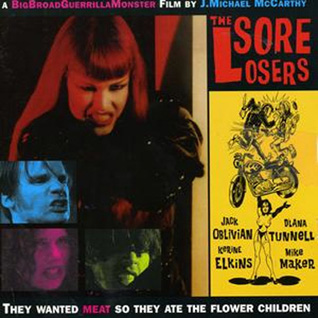
Framed Rock Prize: Artist Unknown.
Image by Michael Whelan from WONDERWORKS, 1979.
Image of QUEEN at Mid-South Coliseum, 1980 from the Karen Pollak Collection. Copyright Guerrilla Monster FIlms 2012.
Image of BOWIE/DIAMOND DOGS at Mid-South Coliseum, 1980 from the Karen Pollak Collection. Copyright Guerrilla Monster FIlms 2012.
Hand drawn images of Queen, Elric, and Mick Jagger by Mike McCarthy circa 1982.
Richard Dadd painted "The Fairy Fellers Master-Stroke." (1855-1864)
The song "39" is the 39th song in Queen's chronology (Night at The Opera).
Freddie has more chest hair on one side of Sheer Heart Attack than the other.
COMIC BUYERS GUIDE (name change!)
DEC 19, 1980 CBG) PRO-QUEEN AGENDA (PART 1)
MAY 29, 1981 (CBG) PRO-QUEEN AGENDA (PART 2)
MAGAZINES (My Queen kick continues...)
WINTER, 1980 EPIC MAGAZINE (Queen, Elric Mention)
(*Note* The four members of KISS can be broken down into these 4 main glam inspirations: Paul Stanley looks and moves like Marc Bolan. Gene Simmons successfully unifies the blood and horror look of Alice Cooper. Ace Frehley represents Bowie and Ronson combined (or Ariel Bender!). Peter Criss is harder to figure out, perhaps something akin to a gentrified New York Doll. The staying power of KISS is that the combine the entirety of Glam into four people, much like the Beatles were Elvis x 4.)
copyright 2012 by Mike McCarthy